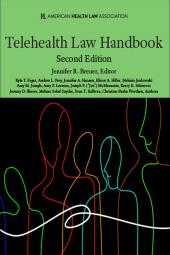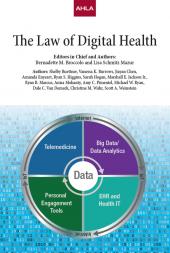AHLA Telehealth Law Handbook (Non-Members)
Select a format
 International Order Inquiry
International Order Inquiry
Select subscription type
Terms & conditions
Subscribers receive the product(s) listed on the Order Form and any Updates made available during the annual subscription period. Shipping and handling fees are not included in the annual price.
Subscribers are advised of the number of Updates that were made to the particular publication the prior year. The number of Updates may vary due to developments in the law and other publishing issues, but subscribers may use this as a rough estimate of future shipments. Subscribers may call Customer Support at 800-833-9844 for additional information.
Subscribers may cancel this subscription by: calling Customer Support at 800-833-9844; emailing customer.support@lexisnexis.com; or returning the invoice marked "CANCEL".
If subscribers cancel within 30 days after the product is ordered or received and return the product at their expense, then they will receive a full credit of the price for the annual subscription.
If subscribers cancel between 31 and 60 days after the invoice date and return the product at their expense, then they will receive a 5/6th credit of the price for the annual subscription. No credit will be given for cancellations more than 60 days after the invoice date. To receive any credit, subscriber must return all product(s) shipped during the year at their expense within the applicable cancellation period listed above.
Subscribers receive the product(s) listed on the Order Form and any Updates made available during the annual subscription period. Shipping and handling fees are not included in the annual price.
Subscribers are advised of the number of Updates that were made to the particular publication the prior year. The number of Updates may vary due to developments in the law and other publishing issues, but subscribers may use this as a rough estimate of future shipments. Subscribers may call Customer Support at 800-833-9844 for additional information.
Subscribers may cancel this subscription by: calling Customer Support at 800-833-9844; emailing customer.support@lexisnexis.com; or returning the invoice marked 'CANCEL'.
If subscribers cancel within 30 days after the product is ordered or received and return the product at their expense, then they will receive a full credit of the price for the annual subscription.
If subscribers cancel between 31 and 60 days after the invoice date and return the product at their expense, then they will receive a 5/6th credit of the price for the annual subscription. No credit will be given for cancellations more than 60 days after the invoice date. To receive any credit, subscriber must return all product(s) shipped during the year at their expense within the applicable cancellation period listed above.
Product description
View a sample of this title using the ReadNow feature
The COVID-19 pandemic ushered in not only an extraordinary need for health care providers to build telehealth capabilities, but also extraordinary regulatory flexibility, as federal and state authorities enacted emergency exceptions and permanent changes to longstanding requirements that had previously posed challenges to the adoption of telehealth. In this changed environment, the American Health Law Association® is pleased to bring you the expanded and updated Second Edition of Telehealth Law Handbook.
The Editor and Authors of Telehealth Law Handbook, Second Edition have expanded the contents to reflect considerations key to understanding today's telehealth legal and operational environment. Maintaining their concise and practical approach to the subject, the authors explain and assess the current state of the law, highlighting risks and opportunities for readers to consider today and into the future.
Coverage includes
- The flurry of regulatory activity governing the use of telehealth brought on by the COVID-19 pandemic;
- Discussion of a 2022 OIG Special Fraud Alert warning practitioners to exercise caution when interacting with telemedicine companies;
- Updated information about non-physician health professionals providing services via telehealth;
- Explanation of how FTC and FDA impact telehealth;
- State requirements for patient consent, provider licensing, the physician-patient relationship, and more;
- Reimbursement rules for telehealth services under Medicare and Medicaid; and
- New appendices reflecting state telehealth Medicaid coverage laws; state telehealth commercial insurance coverage laws; a sample telehealth policy and procedure; and a sample employer-provider telemedicine services agreement
Appendices C and D are available to Customers via the Download Center.
AHLA recommends this book to advisors of health care entities, technology developers, policy makers, payers, investors, and anyone working to offer telehealth to patients, wherever they may be.
Editor: Jennifer R. Breuer
Authors: Kyle Y. Faget, Andrea L. Frey, Jennifer A. Hansen, Elinor A. Hiller, Melania Jankowski, Amy M. Joseph, Amy F. Lerman, Joseph P. McMenamin, Kerry K. Sakimoto, Jeremy D. Sherer, Melissa Sobel Snyder, Sean T. Sullivan, Christine Burke Worthen.
For full author bio list, please click here.
The 1st Edition ISBN was 9781632813459.
eBooks, CDs, downloadable content, and software purchases are noncancelable, nonrefundable and nonreturnable. Click here for more information about LexisNexis eBooks. The eBook versions of this title may feature links to Lexis+® service for further legal research options. A valid subscription to Lexis+ is required to access this content.
Published in March 2023.
Table of contents
Preface
Recent Titles from the American Health Law Association
About the Editor
About the Authors
Acknowledgements
About the American Health Law Association
Chapter 1 Telehealth Models
1.1 Introduction And The Impact of Covid-19
1.2 Telehealth Communication Platforms
1.2.1 Synchronous Communication
1.2.2 Asynchronous Communication
1.2.3 Participant-Type Communication Models
1.2.3.1 The Provider-To-Provider Model
1.2.3.2 The Provider-To-Provider Extender Model
1.2.3.3 Direct-To-Consumer Communication
1.3 Remote Patient Monitoring
1.4 Conclusion
Chapter 2 Telehealth Regulatory Requirements
2.1 Introduction
2.2 Telehealth Practice Requirements
2.2.1 Provider-Patient Relationship
2.2.2 Provider And Patient Validation
2.2.3 Consent
2.2.4 Follow-Up Care Requirements
2.2.5 Patient And Provider Type And Location Requirements
2.2.6 Technology Requirements
2.2.7 Medical Records And Privacy
2.3 Remote Prescribing
2.3.1 The Ryan Haight Act
2.3.2 The Support Act
2.3.3 State Requirements
2.4 Corporate Practice of Medicine And Fee Splitting
Chapter 3 Licensing Issues For Physicians
3.1 Introduction And Impact of Covid-19
3.2 State Telehealth Licensing Requirements For Physicians
3.2.1 States With Full Licensure Requirements
3.2.2 States With Special License Or Registration Requirements
3.2.3 States With Bordering State Exceptions
3.2.4 Interstate Medical Licensure Compact
3.2.5 Physician-To-Physician And Infrequent Consultation Exceptions
3.2.5.1 Physician-To-Physician Consultations
3.2.5.2 Infrequent Consultation Exceptions
3.2.6 Supervision of Allied Health Professionals
Chapter 4 Considerations For Non-Physician Telehealth Providers
4.1 Allied Health Professionals And Telehealth
4.1.1 Types of Allied Health Professionals
4.2 Telehealth Practice Standards For Allied Health Professionals
4.3 Telenursing
4.4 Telebehavioral Health
4.5 Telephysical Therapy
4.6 Supervision of Allied Health Professionals
4.7 Licensure Issues For Health Coaches
Chapter 5 Payment And Reimbursement
5.1 Introduction
5.2 Medicare Coverage of Telehealth Services
5.2.1 Qualifying Rural Geographic Area
5.2.2 Qualifying Originating Site
5.2.3 Eligible Distant Site Practitioners
5.2.4 Eligible Telecommunications Technology
5.2.5 Eligible CPT/HCPCS Codes
5.3 Medicare Coverage of Telehealth During The Covid-19 PHE And Immediately Post-PHE
5.4 Medicare Billing, Coding, And Payment For Telehealth Services
5.5 Medicare Coverage of Other Remote Practitioner Services
5.6 Medicare Advantage Flexibility to Provide Additional Telehealth Services
5.7 Medicaid Coverage of Telehealth Services
5.8 Commercial Insurance Coverage of Telehealth
5.8.1 Telehealth Commercial Coverage And Parity Laws
Table 5.1: States With Telehealth Commercial Insurance Coverage Parity Laws
Table 5.2: States Without Telehealth Commercial Insurance Coverage Parity Laws
5.8.2 Telehealth Payment Parity Laws
Table 5.3: States With Telehealth Commercial Insurance Payment Parity Laws
Table 5.4: States Without Telehealth Commercial Insurance Payment Parity Laws
5.8.3 Interaction Between Telehealth Coverage And Payment Parity
5.8.4 How Differences in Telehealth Insurance Laws Affect Patients And The Marketplace
Chapter 6 Fraud And Abuse
6.1 Introduction
6.2 Legal Authorities
6.2.1 Federal Anti-Kickback Statute
6.2.2 Beneficiary Inducements—Civil Monetary Penalties Law
6.2.3 Federal Physician Self-Referral Law
6.2.4 Federal False Claims Act And Civil Monetary Penalties Law
6.2.5 State Fraud And Abuse Laws
6.3 Enforcement
6.3.1 U.S. Department of Justice
6.3.2 Office of Inspector General
6.3.3 State Medical Boards
6.4 Fraud And Abuse in The Broader Telehealth Policy Debate
Chapter 7 Privacy And Security Issues in Telehealth
7.1 HIPAA
7.2 State Law
7.3 Requirements of The Federal Trade Commission And The Food And Drug Administration
7.4 Covid-19 Rules
7.5 The European Union's General Data Protection Regulation
Chapter 8 Liability Issues
8.1 The Provider-Patient Relationship
8.1.1 Formation of The Relationship
8.1.2 Prescribing
8.2 Professional Liability
8.2.1 Duty
8.2.2 Breach
8.2.3 Agency
8.2.4 Informed Consent
8.2.4.1 Consent of Those Under Disabilities
8.2.5 Causation
8.2.6 Locus of Care
8.2.7 Risk Management
8.2.8 Insurance
8.2.9 Other Considerations
8.3 Product Liability
8.4 Conclusion
Chapter 9 Mobile Health Technology
9.1 FDA Regulation of Mobile Health Technology
9.1.1 What Is Mobile Health Technology?
9.1.2 What Is A Medical Device?
9.1.3 How The FDA Approaches Regulation of mHealth Technology
9.1.4 FDA Policy Changes Resulting From Section 3060 of The 21st Century Cures Act
9.1.5 General Wellness mHealth Devices
9.1.6 Mobile Medical Applications
9.1.7 Clinical Decision Support Software
9.2 Other Federal Agency Regulation
9.3 Conclusion
Appendix A 50-State Survey: Telehealth Medicaid Coverage Laws
Appendix B 50-State Survey: Telehealth Commercial Insurance Coverage Laws
Appendix C Sample Policy: Telehealth Policy And Procedures
Appendix C-1 Sample Operational Workflow And Tips For Effective Telehealth Encounters Using Videoconferencing Technology
Appendix C-2 Consent to Participate in A Telehealth Consultation
Appendix D Sample Agreement: Employer-Provider Telemedicine Services Agreement
Index




